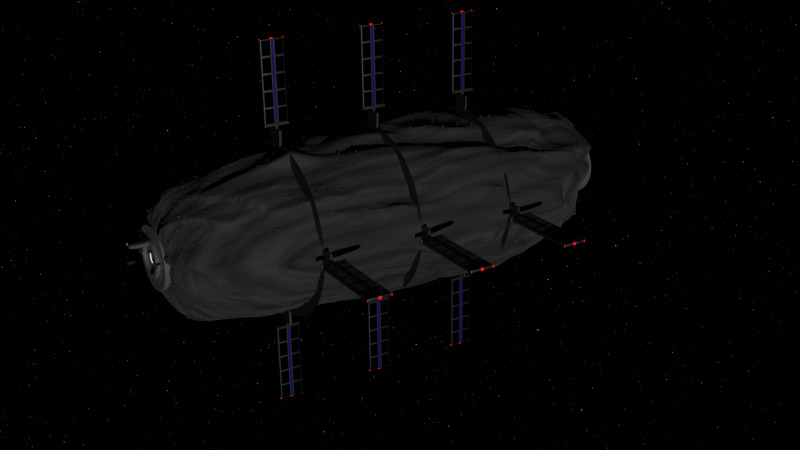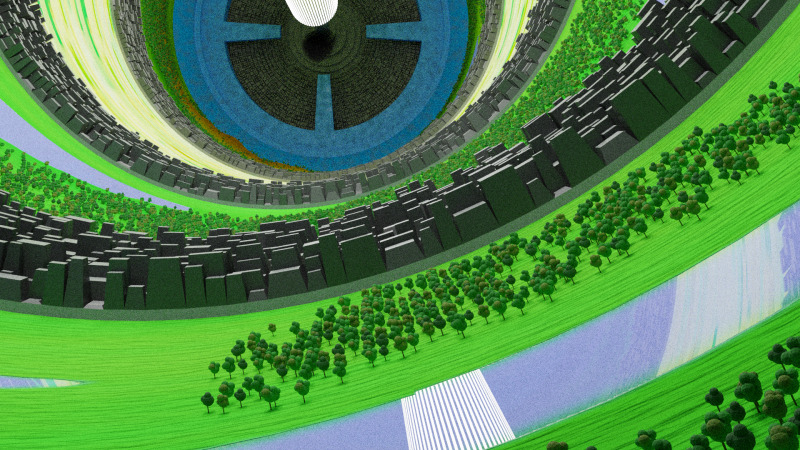Serendip Belt

One of the major powers of the Islands, Serendip Belt is a belter culture strongly bound together with their social identity. They value politeness, skills and competence, and strive hard to be good at what they do in order to better fit into that society. The pressure to find a valued place in that society can be tough though, especially when robots dominate much of the labour force.
Serendip Belt is not a single world, but trillions of wordlets that orbit its star in a large belt just on the outer edge of the system’s habitable zone. With a total population of two billion, the belt is a web of activity, with stations, hollowed out asteroids, small ships and industrial complexes providing a thriving social and economic network bound together in a tight community. Whilst many belter communities tend to be united only in their independence, the citizens of Serendip Belt tend to view themselves as a single nation.
The capital of this nation is C-Jammer, the ancient ship that left Terra some three thousand years ago and made the Slower Than Light journey to the Islands along with its sister ships van der Lubbe and Voyageur. The population of C-Jammer was mostly Anglo-American and Scandinavian, with some Russian colonists as well. The 100,000 colonists spent most of their time in cold sleep, but C-Jammer had enough capacity to support the entire population awake if necessary. It was always considered a possibility that no habitable planet would be found at their destination, and a lot of time might need to be spent awake about the vessel.
C-Jammer is now the capital of Serendip Belt, and its voyaging days are long over. Its engines have been mostly dismantled replaced with ice mining facilities, and the front section has been repurposed as a star port.
The advantage of a belter society is that it’s possible to come out of Jump really close to the starport. Space traffic control prefers people to exit around 50,000km to 100,000km from the starport however in order to avoid accidental collisions, and for ships to leave this area as quickly as possible. Ships can be seen leaving only a few thousand kilometres from the starport, making travel to and from C-Jammer really easy.

Coming out of Jump Space what you see is an eight kilometre long asteroid made up of dark, slightly reddish rock. Heat sinks protrude from the side of it, lit up brightly to warn incoming ships since they rotate with the rest of the rock every 63 seconds. The rock is about 2km wide, with a docking bay at the front end for ships to dock inside. The largest ships are expected to stay outside, and there are numerous trading platforms, warehouses and services within 100km of the C-Jammer itself to serve these.
For ships smaller than a couple of thousand tonnes, docking in the main bay is the easiest, especially if you want access to the full resources of the city. Facilities are good here, but custom checks can be quite strict, and any ship that looks suspicious (or who wasn’t fully cooperate with space traffic control) is likely to be marked for a customs inspection. Such inspections can take several hours, and the crew aren’t permitted to leave the ship before it has been completed. However, inspections tend to be fair (unless the crew is rude to the inspectors), and they’re simply to perform safety checks and to look for illegal goods – normally nuclear or biological weapons, or forbidden drugs or technology.
Once inspections are complete, the crew is left free to leave the station. Depite the class A designation of the starport, there are few recreational facilities actually at the port, instead it is expected that visitors head down into the main cities. Weapons are not allowed to be carried on C-Jammer, and a weapons check will be performed whenever visitors leave the docking bay.
The most common language spoken here and in the rest of the belt is a form of Anglic. It’s understandable (with a bit of effort) by Imperium travellers, but a lot of the inhabitants, especially the starport staff, speak full Anglic.

The view once you do so is impressive – the starport opens out onto a view over 8km of habitat cylinder. A hub runs through the middle, often shrouded in clouds through which shines the interior lighting. A kilometre ‘beneath’ the central hub is the floor of the station, four strips of green and blue split by dense city blocks.
The Garden strips are divided by their rough purpose. The first is the Garden Park, set aside mostly for recreation with a river running all around it. The second is the Garden Forest, mostly dense managed woodland. The third is the Garden Farms, which is set aside for intensive agriculture, and the last is the Wild Garden, which is unmanaged and a mixture of water, forest and hills to provide a number of natural habitats.
Dock Town is immediately outside the star port, up against the front end cap. There is a TAS lodge, several high class hotels, shops and plenty of places to meet other traders and pick up news and deals. The warehousing surrounds the dock areas, so the entire area is busy with traffic, both human and robots. Robots (or ‘droids’ as they are called here) are ubiquitous aboard C-Jammer, and indeed across the Belt. They were used extensively during the journey to reduce the need for an awake human crew, and the habit has continued. A lot of them are humanoid, but obviously artificial – normally coloured plastic skins over a humanoid skeleton. The colours are important, since it denotes the level of capability of the machine.

White or Grey are capable of manual labour and not much else, many are barely capable of speech though understand spoken instructions.
Red are engineering droids designed for hazardous environments, such as high heat or radiation. They tend to be heavily shielded, and have a greater deal of intelligence about the environment they work in.
Green are designed for social situations, and have a full range of social and interpersonal skills for helping them interface with people. They may be found serving in lower class restaurants or acting as receptionists or help staff.
Blue are technical, with computer, medical or electronic skills and the knowledge to go with it. They aren’t often seen in public since they rarely need to leave the site that they are assigned to.
Black droids are rarely seen, and are the only ones programmed to use weapons. Ownership of them is restricted to the government, and even they use them only in the most extreme circumstances. They will have full body armour and heavy weapons, and are programmed with tactic and technical skills as well as the capacity to kill humans.
All droids are considered machines with no legal autonomy of their own. Except for the security droids, none are permitted to harm humans – in theory the programming was updated when non-humans were discovered, but there are tales of incomplete programming in some older models.
Detractors of Serendip Belt accuse them of being slave owners, and there are some droid rights organisations within the Belt – though being a member of such an organisation is considered illegal. There is also the issue of becoming dependent on a droid based society, but the expense of owning one, and the fact that most other high tech societies make use of other forms of mechanisation for most of the jobs that droids do means this argument is often dismissed. Unemployment amongst humans is low, since the government tries to find jobs for everyone, even if it’s just cleaning floors. There are a lot of clean floors in the C-Jammer.
The number of humanoid and semi-humanoid robots on C-Jammer and elsewhere in the Belt can be a surprise to first time visitors, so a short introductory course is available on docking. One thing that is made clear is that droids are considered (and for the most apart do appear to be) non-sentient.
Since anti-grav doesn’t work within the C-Jammer travel to other parts is either by rail along the hull or wheeled vehicle. Or walking – it’s just over a kilometre to Sleeper Town, so named since this is where the colonists slept during the initial journey. There are plenty of easy routes across the Garden Park, and thought it sometimes rains people who have been stuck in a ship for a week or more often enjoy the exercise.
Sleeper Town is now mostly residential, but also has a lively nightlife and some of the best restaurants and hotels – the most exclusive being Fresh Air which overlooks the lakes of Garden Forest. For visiting Aslan and Vargr though, the food can be disappointing. After centuries of surviving in a limited ecology, the society of Serendip Belt have mostly turned vegetarian. Meat is available, and the locals eat it, but in much smaller quantities than is common in much of the Imperium. Even the vegetarian food tends to be bland and subtle in flavour, though there are a number of restaurants which provide heavily spiced curries.
Once you get into any of the towns it is like being in a space station – streets are passages beneath the main buildings, with only the upper floors having a view of the interior gardens. The towns are busy, well lit and clean, and everything tends to be in good repair.
The culture here is rather conservative, and also elitist. Promotion is expected to be due to skill and experience, and testing and measurement is a common fact of life. Locals are expected to sit several exams a year, covering aspects such as safety, culture and technical abilities. Scores are made public, so everyone knows if you’re falling behind, and since socialising with someone with low scores is discouraged, the pressure to succeed is high. The suicide rate in Serendip Belt is amongst the highest in the Islands.
Mostly this is transparent, except that the majority of people visitors will interact with are good at what they do, and actually take pride in their work. Locals are polite, smartly dressed (full suits and ties are common for men and women) and difficult to bribe. They expect others to be the same, and are often disappointed when reality doesn’t match their expectations, especially if a ship’s safety and service record isn’t up to date.
Serendip Belt is in New Islands Subsector, Reft, 1323. For more information on the system, see the detailed entry.